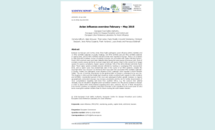Surveillance report: Avian influenza overview (February – May 2018)
The “Avian influenza overview” report is published quarterly and provide an update of the developments of avian influenza viruses in EU/EEA and worldwide, in particular with a view to describe the evolution of virus spread from certain regions towards the EU. In case of significant changes in the epidemiology of avian influenza, these reports could be needed more frequently.
The report is published jointly by the European Food Safety Authority (EFSA), the European Centre for Disease Prevention and Control (ECDC) and the European Union Reference Laboratory for Avian influenza (EURL). Avian influenza is an infectious viral disease in birds, including domestic poultry. Avian influenza is mainly found in birds, but under certain circumstances infections can also occur in humans even though the risk is generally very low.
Executive Summary
Between 16 February and 15 May 2018, three highly pathogenic avian influenza (HPAI) A(H5N6) and 11 HPAI A(H5N8) outbreaks in poultry holdings, one HPAI A(H5N6) and one HPAI A(H5N8) outbreak in captive birds, and 55 HPAI A(H5N6) wild bird events were reported in Europe. There is no evidence to date that HPAI A(H5N6) viruses circulating in Europe are associated with clades infecting humans. Fewer HPAI wild bird cases have been detected than during the same period of previous year. Most of mortality events among wild birds involved single birds and species listed in the revised list of target species for passive surveillance. Raptor species constitute 74% of the HPAI-infected wild birds found dead. Those raptor species probably became infected by hunting or scavenging HPAI virus-positive birds, and so raptor cases may predominate later in the course of an HPAI epidemic. Despite the important HPAI virus incursion via wild birds there have been few associated HPAI A(H5N6) outbreaks in poultry. Fifteen low pathogenic avian influenza (LPAI) outbreaks were reported in three Member States. The risk of zoonotic transmission to the general public in Europe is considered to be very low. The situation in Africa and the Middle East should be closely monitored with regards to HPAI A(H5N1) and A(H5N8). Uncontrolled spread of the virus and subsequent further genetic evolution in regions geographically connected to Europe may increase uncertainty and the risk for further dissemination of virus. Long-distance migrating wild birds from southern Africa, e.g. the common tern ( Sterna hirundo ), may be included in targeted active surveillance schemes at a few priority locations in Europe in order to detect HPAI A(H5)-infected migrating birds early. However, the risk of HPAI introduction from non-EU countries via migratory wild birds to Europe is still considered to be much lower for wild birds crossing the southern borders than for those crossing the north-eastern borders.
Download





